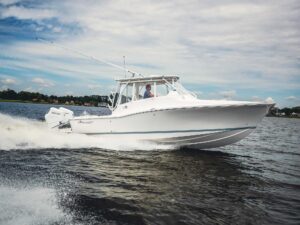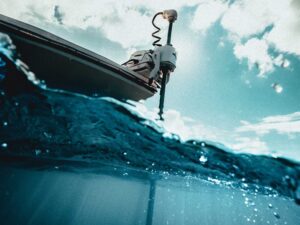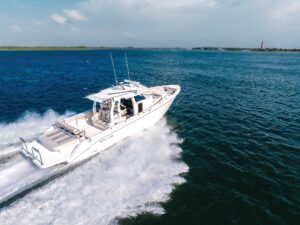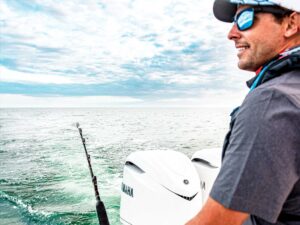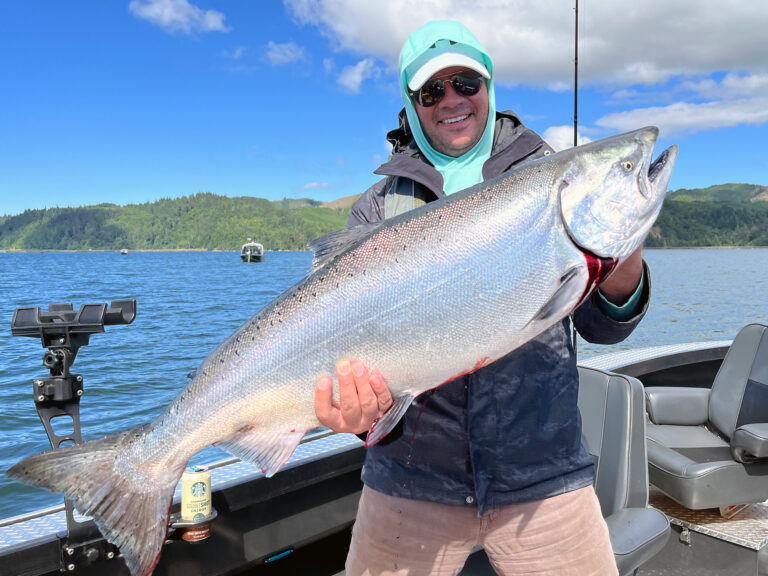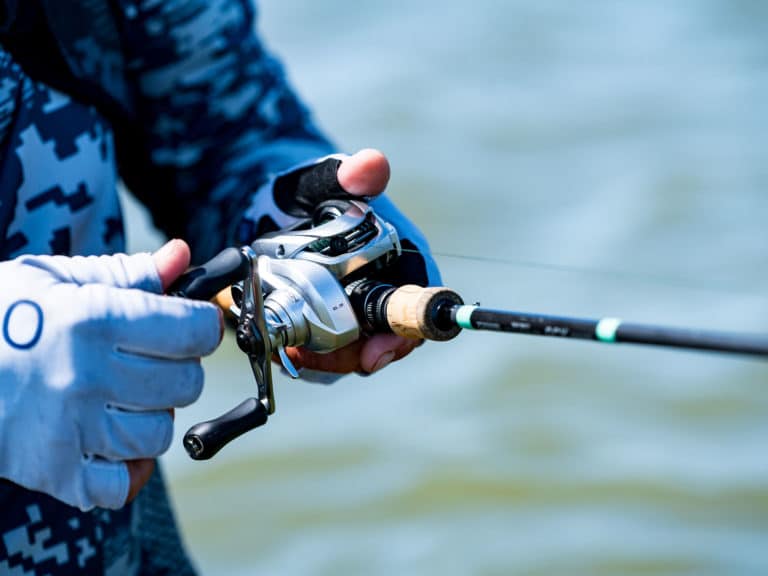If you run any kind of skiff in shallow water, this column just became a must-read!
Lots of people get by without jack plates — those add-on brackets that provide two more adjustability dimensions to your outboard engine trim, straight up and down. Are you one of those people who ask, “Why bother?”
The jack plate accomplishes several significant functions:
- It enables you to run in shallower water than a standard engine mount.
- It allows you to get up on plane in shallower water than a standard engine mount.
- When trimming an engine for best performance, a jack plate affords you better fuel economy thanks to channeling thrust in the most efficient direction.
Without a Jack Plate
When you’re in shallow water, your propeller represents the deepest part of your boat. Whether you’re already running on plane or need to get up on plane from a standstill, your likely deterrent stems from the prop and skeg hanging below your hull.
When you’re ready to throttle up in shallow water — without a jack plate — the general procedure involves “spinning” your boat up onto plane. This process consists of trimming the tabs all the way down, turning the wheel hard over and jamming the throttles forward. The thrust from your prop pushes it up and away from the bottom. Once you build momentum, you straighten out the wheel and (hopefully) continue on your way at speed.
Simply trimming up your drive actually hinders performance, as it alters the direction of your propeller’s thrust to an inefficient angle. Additionally, tilting your engine degrades your performance as the water approaching the prop gets blocked by the cavitation plate as the angle of the engine changes outward.
A better way to “shallow up” your prop and skeg is to lift them straight up rather than tilt them. Mounting your outboard to a hydraulic- or electric-powered jack plate affixed to the transom of the boat allows you to lift your engine vertically rather than change the angle of thrust.
How Does It Work?
On standard engine mounts (with no jack plate), the outboard must be mounted low enough so as not to cause cavitation when running into chop or executing turns. In calm water on a straight course, it could be mounted higher, but when it’s bolted tightly to the transom, moving it up or down obviously can’t be accomplished. That’s where a jack plate comes in.
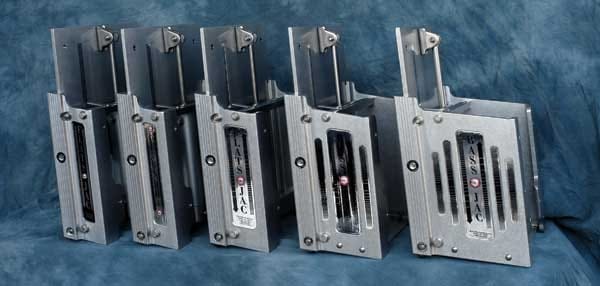
Jacking up the engine to run across shallow water puts the cavitation plate in front of the propeller, actually encouraging cavitation. Lifting the engine vertically keeps the plate above the propeller and aligned with the movement of the boat. Thrust channels directly parallel to the surface of the water — the most efficient direction.
A tilted engine throws a rooster tail of water up into the air. If you throw water up, you waste energy. Plus, Newton’s Third Law of Motion says that thrust upward must equal thrust downward. If you’re in shallow water, you don’t want your boat to be pushed down, especially at the stern. An engine tilted bow-up at a high angle to go across shallow water will raise the bow and lower the stern, making the draft of your boat deeper.
A boat equipped with a jack plate can avoid all those negative consequences of tilting the engine. By simply raising the engine up with the jack plate until it is just on the verge of cavitation, you can run and start up in far shallower depths than you ever imagined. If you want the ability to run with impunity in shallow water, meaning without tearing up either the bottom habitat or your equipment, one way or another you need to raise the skeg and propeller on your boat higher, and the jack plate represents the best possible means to accomplish that.
One other thing many knowledgeable boaters ask: “Why doesn’t lifting the prop up like that raise it right out of the water?” For the same reason that high-speed performance boats use surface-piercing props. Once the water under the boat passes the trailing edge of the transom, it angles upward. So even when the prop is higher than the bottom of the boat, it sits far enough back to work in solid water.
Better Gas Mileage Too
A jack plate also increases fuel efficiency. Simple logic dictates that when you can channel-thrust directly parallel to the surface of the water rather than up or down in comparison, you waste less energy. Additionally, the lower drive unit, prop and skeg all create drag in the water. With a jack plate, you can raise the engine higher in the water column, thereby decreasing drag. Certainly, you may need to lower it farther into the water in rough-water conditions or in turns. But calm conditions will allow you to run with the engine higher and burn less fuel.
Make Planing Easier
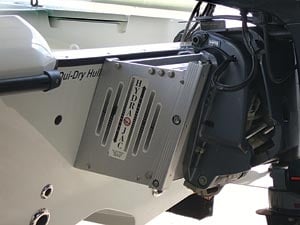
You can simplify the process of “spinning up” by using a jack plate. First, raise the jack plate all the way up. Then, apply full throttle with the wheel straight ahead. Once up on plane, you can lower the jack plate if necessary. Rather than the stern “squatting down” in the water initially, the way it would with a standard engine mount and the engine trimmed up, the stern moves forward as the jack plate allows the engine’s thrust to work, keeping the prop high enough to miss the bottom. As the boat starts to come over onto plane, the engine lowers to the proper level for high-speed cruising.
Slowing down into shallow water essentially reverses the above procedure. As the boat slows, the captain raises the jack plate; some also tilt the engine out at the same time, so that as the stern drops to its lowest point coming off plane, the engine is already jacked up high and tilted out a bit to minimize draft.
Jack plates come in both manual and hydraulic versions, and size and setback depend on the size of engine you plan to mount with it. Obviously, if you want to adjust the height of your engine while under way, the hydraulic type is the only way to go. Manual jack plates retail for anywhere between $150 and more than $1,000. Hydraulic models run from about $650 on the low end to almost $2,000 for a top-of-the-line model.
Jack-Plate Manufacturers: (Special thanks to Bob’s Machine Shop for providing all photography used in this feature)
Bob’s Machine Shop
Tampa, Florida
800-966-3493 (orders)
813-247-7040 (tech line)
Cook Marine
Duncan, Oklahoma
580-252-1699
Detwiler Industries
St. Paul, Minnesota
651-486-2010
Panther Marine Products St. Paul, Minnesota
651-486-2010
R&R Design
Terrell, Texas
972-563-1789
T-H Marine Supplies Inc.
Huntsville, Alabama
256-772-0164
T&R Marine Corporation
Perry, Florida
850-584-4261

